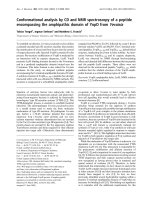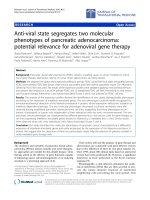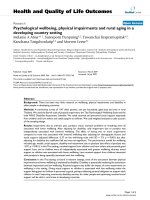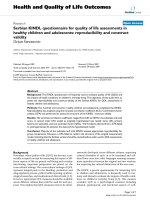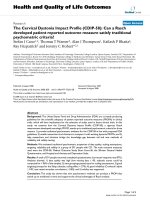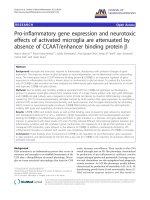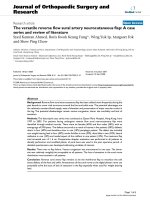báo cáo hóa học:" The OnyCOE-t™ questionnaire: responsiveness and clinical meaningfulness of a patient-reported outcomes questionnaire for toenail onychomycosis" potx
Bạn đang xem bản rút gọn của tài liệu. Xem và tải ngay bản đầy đủ của tài liệu tại đây (226.13 KB, 8 trang )
BioMed Central
Page 1 of 8
(page number not for citation purposes)
Health and Quality of Life Outcomes
Open Access
Research
The OnyCOE-t™ questionnaire: responsiveness and clinical
meaningfulness of a patient-reported outcomes questionnaire for
toenail onychomycosis
Lori P Potter
1
, Susan D Mathias
1
, Monika Raut
2
, Farid Kianifard
3
and
Amir Tavakkol*
3
Address:
1
Ovation Research Group, San Francisco, CA, USA,
2
Ortho Biotech Clinical Affairs LLC, Bridgewater, NJ, USA and
3
Novartis
Pharmaceuticals Corporation, East Hanover, NJ, USA
Email: Lori P Potter - ; Susan D Mathias - ; Monika Raut - ;
Farid Kianifard - ; Amir Tavakkol* -
* Corresponding author
Abstract
Background: This research was conducted to confirm the validity and reliability and to assess the
responsiveness and clinical meaningfulness of the OnyCOE-t
™
, a questionnaire specifically designed to
measure patient-reported outcomes (PRO) associated with toenail onychomycosis.
Methods: 504 patients with toenail onychomycosis randomized to receive 12 weeks of terbinafine 250
mg/day with or without target toenail debridement in the IRON-CLAD
®
trial completed the OnyCOE-t™
at baseline, weeks 6, 12, 24, and 48. The OnyCOE-t™ is composed of 6 multi-item scales and 1 single-
item scale. These include a 7-item Toenail Symptom assessment, which comprises both Symptom
Frequency and Symptom Bothersomeness scales; an 8-item Appearance Problems scale; a 7-item Physical
Activities Problems scale; a 1-item Overall Problem scale; a 7-item Stigma scale; and a 3-item Treatment
Satisfaction scale. In total, 33 toenail onychomycosis-specific items are included in the OnyCOE-t™.
Clinical data, in particular the percent clearing of mycotic involvement in the target toenail, and OnyCOE-
t™ responses were used to evaluate the questionnaire's reliability, validity, responsiveness, and the
minimally clinical important difference (MCID).
Results: The OnyCOE-t™ was shown to be reliable and valid. Construct validity and known groups
validity were acceptable. Internal consistency reliability of multi-item scales was demonstrated by
Cronbach's alpha > .84. Responsiveness was good, with the Treatment Satisfaction, Symptom Frequency,
Overall Problem, and Appearance Problem scales demonstrating the most responsiveness (Guyatt's
statistic of 1.72, 1.31, 1.13, and 1.11, respectively). MCID was evaluated for three different clinical
measures, and indicated that approximately an 8.5-point change (on a 0 to 100 scale) was clinically
meaningful based on a 25% improvement in target nail clearing.
Conclusion: The OnyCOE-t™ questionnaire is a unique, toenail-specific PRO questionnaire that can be
used with confidence in future studies of toenail onychomycosis. MCID was evaluated for three different
clinical measures, and indicated that approximately a 7-point change (on a 0 to 100 scale) was clinically
meaningful based on a 12.5% improvement in target nail clearing.
Published: 15 August 2006
Health and Quality of Life Outcomes 2006, 4:50 doi:10.1186/1477-7525-4-50
Received: 25 March 2006
Accepted: 15 August 2006
This article is available from: />© 2006 Potter et al; licensee BioMed Central Ltd.
This is an Open Access article distributed under the terms of the Creative Commons Attribution License ( />),
which permits unrestricted use, distribution, and reproduction in any medium, provided the original work is properly cited.
Health and Quality of Life Outcomes 2006, 4:50 />Page 2 of 8
(page number not for citation purposes)
Background
Onychomycosis is a common, chronic fungal infection of
the keratinized tissue of the nail bed and nail plate that
may impact patients' quality of life. Patients often experi-
ence pain and discomfort, and normal tactile functions
can be impaired or lost. Toenail dystrophy can interfere
with walking, standing, exercise, or proper shoe fit. Like
other visible dermatologic imperfections, onychomycosis
has both psychosocially and physically detrimental effects
[1]. Patients report concerns about nail appearance,
embarrassment, reduced self-esteem, and social with-
drawal. Furthermore, patients may fear injury and spread-
ing the infection to others [2].
To document the effect of onychomycosis on quality of
life, Lubeck et al. [3] developed a patient-reported out-
comes (PRO) questionnaire consisting of general and dis-
ease-specific measures (including symptom frequency
and severity), which was used in a telephone study of 916
cases and 673 controls. Persons with toenail and/or fin-
gernail onychomycosis reported statistically significantly
lower quality of life scores on almost all measures, includ-
ing pain, general health, social functioning, mental
health, and functional limitation, compared with
matched controls.
Subsequent studies have attempted to demonstrate the
applicability of PRO results and their value to clinicians
[4,5]. Following their initial research, Lubeck et al. con-
ducted a validation study, in which they measured their
questionnaire's responsiveness, or sensitivity to change, in
a population of patients receiving usual and customary
care for onychomycosis [4]. Changes in PRO scores were
compared between patients who improved clinically and
those who did not improve, based on the physician's sub-
jective determination of clinical status at each visit. While
onychomycosis-specific scales were responsive to clinical
improvement, while no statistically significant changes
were reported in a clinically stable group of patients [4].
Other studies of onychomycosis have had limited success
linking PRO results to clinical status in onychomycosis. In
a multinational study, Drake et al. [5] divided 532 toenail
onychomycosis patients into two groups, based on the
extent of nail involvement, and compared their quality of
life scores. Patients with whole-nail involvement reported
significantly lower quality of life scores than those with
half-nail involvement. However, this study could not
measure the responsiveness of PRO to changes in clinical
status of patients.
In a telephone study of clinical trial participants, Drake et
al. [6] attempted to correlate the quality of life scores with
a patient-reported global severity rating. However, the
study failed to show a clear relationship between quality
of life factors (such as pain, discomfort, or psychosocial
problems) and the overall severity rating, suggesting that
severity and quality of life may be two distinct, non-over-
lapping measures.
The Drake studies illustrate some of the problems associ-
ated with clinical interpretation of PRO measures. Com-
paring PRO results to objective clinical assessment will
provide a context for understanding the impairment in
PRO associated with onychomycosis. Responsiveness and
clinical meaningfulness are psychometric properties,
which depend on clinical information, ideally objective
information, such as a laboratory test result or quantifia-
ble improvement. Moreover, there is a lack of prospective
trial data in prior studies to demonstrate the impact of
PRO on objective clinical measures associated with
response to treatment of onychomycosis.
Thus, the objective of this current study was to fully vali-
date the newly developed toenail-specific PRO question-
naire, the OnyCOE-t™, and in particular, to use objective
clinical measures to assess its responsiveness and clinical
meaningfulness, as part of a prospective trial of patients
undergoing treatment for onychomycosis.
Methods
Study design and participants
Data were collected during the Improving Results in Ony-
chomycosis – Concomitant Terbinafine (Lamisil
®
) and
Debridement (IRON-CLAD
®
) trial, a prospective, open-
label, randomized, multi-center study designed to evalu-
ate the efficacy and safety of terbinafine. All eligible
patients (N = 504) were randomized to one of two treat-
ment groups; both groups received 12 weeks of terbin-
afine therapy, but only one group received aggressive
debridement of the target toenail in addition to oral treat-
ment. A randomization list was produced using a vali-
dated system that automates the random assignment of
treatment groups to randomization numbers in a 1:1
ratio.
The study protocol was approved by a local institutional
review board at each center and was carried out in accord-
ance with Good Clinical Practice guidelines and the Dec-
laration of Helsinki. Written informed consent was
obtained from each subject prior to enrollment. Patients
were aware of the reason for debridement, and the proce-
dure was explained to them prior to obtaining consent.
Debridement was performed at baseline, and weeks 6, 12,
and 24 [Table 1].
The IRON-CLAD
®
study was designed to be inclusive (i.e.,
representative of onychomycosis patients who typically
visit a podiatry practice). However, subjects with pre-exist-
ing liver disease, gastrointestinal malabsorption, neph-
Health and Quality of Life Outcomes 2006, 4:50 />Page 3 of 8
(page number not for citation purposes)
ropathy or blood disorders, liver or kidney dysfunction,
and those with HIV or immunocompromized were
excluded.
Study medications were provided to participants at no
charge. Patient compensation was nominal and included
the actual cost of transportation, parking, or other small
expenses associated with participating in the study. No
other compensation actual or implied was provided.
Patients self-administered the OnyCOE-t™ questionnaire
at the time of enrollment (baseline) and at every sched-
uled visit for the duration of the study (Week 6, Week 12,
Week 24, and Week 48), or upon early discontinuation
from the study.
Patient-reported outcome measures
The questionnaire was adapted from an existing validated
instrument [3,4] that had been used to study onychomy-
cosis of both the toenails and fingernails. It was revised to
include only toenail-specific items; the new version of the
questionnaire (the OnyCOE-t™ questionnaire) is com-
posed of 33 items, with 6 multi-item scales and 1 single-
item scale:
• A 7-item Toenail Symptom assessment, which com-
prises both Symptom Frequency (5 response categories: 1
= never, 5 = very often) and Symptom Bothersomeness
scales (5 response categories: 1 = not at all bothered, 5 =
extremely bothered)
• An 8-item Appearance Problems scale (4 response cate-
gories: 1 = very much a problem, 4 = not a problem)
• A 7-item Physical Activities Problems scale (4 response
categories: 1 = very much a problem, 4 = not a problem)
• A 1-item Overall Problem scale (4 response categories; 1
= very much a problem, 4 = not a problem)
• A 7-item Stigma scale (5 response categories: 0 = does
not describe me at all, 4 = describes me very well)
• A 3-item Treatment Satisfaction scale (5 response cate-
gories: 1 = very satisfied, 5 very dissatisfied)
For example, patients were asked: "During the past 4
weeks, how much of a problem were the following
because of your nail fungal condition: Being embarrassed
by the appearance of your nails?" or "Discomfort of pain
from wearing shoes?" The response options ranged from
1 ("Very much a problem") to 4 ("Not a problem").
All items in the OnyCOE-t™ questionnaire were trans-
formed to a 0 to 100 scale and scored so higher scores
indicated better functioning. Each scale score was calcu-
lated as an average of all non-missing items if at least half
of the items making up the scale were non-missing. Vali-
dation analyses were conducted to confirm that the
revised questionnaire is valid and reliable and to assess
responsiveness and calculate a minimally clinical impor-
tant difference.
Clinical outcomes
Clinical outcomes were based on mycology testing per-
formed throughout the study (Culture and KOH results)
and on examination of target toenail, specifically percent
of the target nail judged clear of infection as well as the
amount of new target nail growth observed.
Clinical assessments were performed by a well-trained,
qualified person, other than the investigator; that person
(nurse/study coordinator) remained blinded to debride-
ment and used an assessment tool to avoid subjective
evaluation. For the clinical assessment, the target nail was
overlaid with a transparent film. The entire nail plate and
the involved nail areas were outlined. The outline was
transferred to a template fitted to the approximate size
and shape of the nail. The template was divided into eight
segments, each representing 12.5% of the nail. At each
assessment, the number of segments involved (i.e.,
infected) was recorded. A segment was counted as infected
only if ≥ 50% of the area of the segment was affected. The
amount of clearing was determined by multiplying the
number of infected segments by 12.5% and subtracting
that percentage from 100%. For each patient, this process
was performed by the same person at every visit.
Table 1: Patient Characteristics
Terbinafine Only Terbinafine + Debridement
N = 258 N = 246
Male 64% 59%
White 63% 64%
Cured (Mycological) 60% 69%
Cure (Complete: Mycological + 100% Clearing) 38% 50%
Age ≥ 65 13% 17%
Mean Age 48.4 (± 12.9)] 49.9 (± 14.1)]
Health and Quality of Life Outcomes 2006, 4:50 />Page 4 of 8
(page number not for citation purposes)
Cure was designated in three ways. "Complete Cure" was
defined as a negative culture and negative KOH, plus
100% clearing of the target nail. "Clinical Cure" was
defined as ≥ 87.5% clearing of the target nail. "Mycologi-
cal Cure" was defined as negative culture plus negative
KOH. Cure status was determined at each clinic visit.
Improvement ("Improved") was defined as a positive
change in the amount of clearing from baseline to end of
study. "Not Improved" was defined as no positive change.
In addition, a three-value categorical outcome of
Improvement ("Improved", "Stable", or "Worsened") was
used to compute the responsiveness of the questionnaire.
Patients in the Stable group showed no change in the
amount of clearing, and patients who Worsened showed
negative change, or decrease in the amount of clearing.
Clinical assessment also included measuring new, clear
nail growth by placing a cut at the proximal nail fold and
measuring nail growth from that point onward. "Clinical
Success" was determined by = 5 mm of clear new nail
growth. Based on the study protocol, nail growth <5 mm
at Week 48 was considered a therapeutic failure (i.e., not
a Clinical Success).
Confirmation of validity and reliability
Construct validity is assessed by examining the relation-
ship between scales or items. Validity is demonstrated
when scales or items that are thought to measure the same
construct have high correlation coefficients; conversely,
items assumed to measure different, unrelated constructs
should have low correlation coefficients.
Known-groups validity evaluates the ability of a question-
naire to discriminate between groups by examining scores
from subjects known to be different. In this study, the
known-groups validity was evaluated using demographic
and clinical criteria.
Internal consistency reliability measures the extent to
which items within each scale correlate with each other to
form a multi-item scale.
Responsiveness
Responsiveness gauges the ability of a PRO measure to
respond appropriately when a patient's clinical state
changes. The analysis of responsiveness included patients
who completed the OnyCOE-t™ questionnaire at baseline
and at the end of the study and who had measures of clin-
ical efficacy (clinical assessment of target nail clearing and
re-growth). Change scores were computed for each scale
by subtracting baseline scores from scores at the end of
study (Week 48). Responsiveness was demonstrated when
subjects who showed clinical improvement had greater,
positive PRO change scores.
Clinical meaningfulness
Clinical meaningfulness was analyzed by estimating the
minimally clinical important difference (MCID) under
different assumptions of nail clearing and new nail
growth. The MCID was calculated based on differences of
12.5% in the degree of toenail involvement, which corre-
sponded to the measurement method dictated by the pro-
tocol to evaluate the percent clearing of mycotic
involvement. The MCID was also calculated based on a
25% difference in the degree of toenail involvement;
increments of 25% were used in analysis of trial data to
categorize severity of mycotic involvement at baseline. In
addition to nail clearing, the MCID estimation was per-
formed based on the Clinical Success criteria, i.e., ≥ 5 mm
of clear new nail growth of the target nail.
Statistical methods
Variable clustering was performed to evaluate the under-
lying structure of the theoretical OnyCOE-t™ scales and
confirmed the existence of six multi-item scales [7]. Con-
struct validity was limited by having no other scales to
compare with the OnyCOE-t™ to establish external (crite-
rion) validity. To test convergent validity, we generated
Pearson's correlation coefficients between all items and
scales, using pooled data.
Known-groups validity was assessed using a Student's t-
test to compare change in patients who were cured (under
all three definitions) versus those who were not; known
groups was assessed using demographic characteristics as
well.
Internal consistency reliability, a measure of the extent to
which items within each scale correlate with each other to
form a multi-item scale, was examined by computing
Cronbach's alpha coefficient. A Cronbach's alpha coeffi-
cient of .70 or greater indicates good internal consistency
of a multi-item scale [8].
In analyses of responsiveness, change scores were tested
against zero using the one-sample t-test. Three groups of
patients resulted from the categorical variable for
Improvement; group scores were used to calculate Guy-
att's statistic, the ratio of the mean change score for each
group divided by the standard deviation for the Stable
group. A statistic of 1.00 or greater (or -1.00 or less when
improvement was denoted by a negative change score)
was considered indicative of a measure highly responsive
to change [9,10]. In addition, the difference in PRO scores
between the Stable group and the Improved group was
evaluated using the two-sample t-test.
For the estimation of the MCID, an analysis of variance
(ANOVA) model for each OnyCOE-t™ questionnaire scale
was fit using target toenail percent clearing or the amount
Health and Quality of Life Outcomes 2006, 4:50 />Page 5 of 8
(page number not for citation purposes)
of new growth of the target toenail as the single predictor
variable. The least squares means estimate for each Ony-
COE-t™ scale score was evaluated for every 12.5% or 25%
difference in toenail clearing, and for clinical success as
indicated by new toenail growth ≥ 5 mm.
For statistically significant comparisons (based on the p-
values from the ANOVA model), the average difference in
mean PRO scores between adjacent categories was used to
estimate the MCID for each scale. The MCID calculation
based on 12.5% difference included eight categories:
12.5%, 25%, 37.5% 50%, 62.5%, 75%, 87.5%, and
100%; the 25% difference included four categories: 25%,
50%, 75%, and 100%. However, when using the amount
of new growth to estimate the MCID for each scale, we
used the difference between the two categories (<5 mm, ≥
5 mm).
All statistical analyses were generated using SAS Software,
Version 8.2 or higher of the SAS System for Windows. No
imputation (e.g., last-observation-carried-forward) was
performed to accommodate missing assessments; analy-
ses included only available data.
Results
Patient demographics
All patients were between 18 and 75 years of age, with a
mean age of 48.5 years (terbinafine only) and 49.7 years
(terbinafine plus debridement). The majority of patients
were Caucasian (63.5%), and approximately two-thirds of
patients were male (61.3%). Treatment groups were bal-
anced with respect to patient characteristics [Table 1].
Validity and reliability
Strong correlations exist between items measuring toenail
symptom frequency, and bothersomeness. All the prob-
lem scales and items – Physical Activities, Physical
Appearance, and Overall Problem – are moderately to
highly correlated. Items expected to correlate highly, for
instance those measuring constructs of embarrassment
about appearance and social stigma, did. For instance, the
Stigma scale and individual items correlated highly with
both Problems with Activities and Problems with Appear-
ance. Treatment Satisfaction correlates most highly with
Symptom Frequency and Symptom Bothersomenesss.
We generally confirmed previous findings, demonstrating
lower scores for females and for younger patients. Scale
scores for cured versus uncured groups were significantly
different, based on mycological cure. For instance, in the
cured group (terbinafine plus debridement), the mean
Symptom Frequency score was 84.2 vs 68.0 in the
uncured group (p < 0.001); Overall Problems scores were
83.4 vs 56.4 (p < 0.001).
All scales demonstrated a high degree of internal consist-
ency, as indicated by alpha coefficients > .70 (.84 to .91).
Responsiveness
Patients in both groups (Improved and Not Improved)
reported positive PRO change scores, as measured by
change from baseline at Week 48 [[Table 2]. The
Improved group demonstrated very good responsiveness,
as shown by positive, statistically significant change in all
measures. In the Not Improved group, Stigma and Treat-
ment Satisfaction scores demonstrated no statistically sig-
nificant change; all other PRO scores in the Not Improved
group showed significant change, but gains were much
smaller than those observed in the Improved group.
Comparison of patients who improved to those who
remained stable using Guyatt's statistic indicated that
Treatment Satisfaction, Symptom Frequency, Overall
Problem and Appearance Problem scales are all highly
responsive, while all other scales were moderately respon-
sive to clinical change [Table 3]. Moreover, results of two-
sample t-tests showed statistically significant differences
(p < .0001 to .0176) between the Improved group and the
Stable group on all PRO scores except Symptom Bother-
someness (p = .3384) (data not shown).
Clinical meaningfulness
Using the 12.5% definition, the MCID estimation for
individual scales ranged from about 5.5 to 8 points, with
the exception of the single item, Overall Problem, which
had an MCID of about 11 points. Differences in the Ony-
Table 2: Mean change in scores from baseline to week 48: Responsiveness based on clinical improvement (clearing of the target nail)
Clinically improved N = 400 Clinically not improved N = 52
Symptom Frequency 34.5 (<.0001) 21.2 (<.0001)
Symptom Bothersomeness 24.1 (<.0001) 14.5 (.0022)
Physical Activities Problems 30.1 (<.0001) 11.3 (.0100)
Appearance Problems 34.4 (<.0001) 13.6 (.0013)
Overall Problem 44.0 (<.0001) 24.5 (<.0001)
Stigma 15.4 (<.0001) 5.1 (.1416)
Treatment Satisfaction 46.1 (<.0001) 1.7 (.8868)
(p-values are from the one-sample t-test)
Health and Quality of Life Outcomes 2006, 4:50 />Page 6 of 8
(page number not for citation purposes)
COE-t™ questionnaire scales at adjacent levels of improve-
ment were not significant at all levels. The overall MCID
using the 12.5% difference in clearing was 7.30 [Table 4].
Under the 25% difference scenario, most of the individual
MCID estimates were consistent (within a point) of the
estimated MCID at 12.5%; the exceptions were Symptom
Frequency and Treatment Satisfaction. Using 25% clear-
ing to calculate MCID, all adjacent comparisons were sig-
nificant. The overall MCID was 8.45 [Table 4].
The MCID assessment was calculated based on the clinical
success criteria, i.e., ≥ 5 mm of clear new nail growth of the
target nail [Table 4]. The Overall MCID for new nail
growth was estimated as 16.63.
Discussion
The goal of this study was to confirm the psychometric
properties of the OnyCOE-t™ questionnaire as a tool for
measuring PRO results specifically related to toenail ony-
chomycosis, and to extend the prior research by evaluat-
ing responsiveness against an objective clinical measure
and to calculate a measure of clinical meaningfulness
[11]. Thus, this study focuses on presenting results of
responsiveness and clinical meaningfulness, which inter-
preted the OnyCOE-t™ scores in clinically relevant terms.
Table 4: Minimal Clinically Important Difference
Average Difference Between Adjacent PRO Scores
Scale 12.5% Difference in nail clearing* 25% Difference in nail clearing* ≥ 5 mm new nail growth
†
Symptom Frequency 6.48 9.12 17.28
Symptom Bothersomeness 5.95 5.84 11.83
Physical Activities Problems 7.54 8.32 17.69
Appearance Problems 8.04 8.69 18.51
Overall Problem 11.19 11.77 25.32
Stigma 5.44 5.21 9.41
Treatment Satisfaction 7.42 9.11 16.37
Overall 7.30 8.45 16.63
* Based on comparisons that are significant at the .05 level
†
Based on comparisons that are significant at the .0001 level
Table 3: Guyatt's statistic and mean change in scales
Scale Worsened N = 12 Stable N = 37 Improved N = 400
Symptom Frequency
Mean Change 21.6 21.0 34.5
Guyatt's Statistic .82 .80 1.31
Symptom Bothersomeness
Mean Change 1.5 18.9 24.1
Guyatt's Statistic .05 .64 .81
Physical Activities Problems
Mean Change 18.3 9.0 30.1
Guyatt's Statistic .55 .27 .91
Appearance Problems
Mean Change 16.3 12.7 34.4
Guyatt's Statistic .53 .41 1.11
Overall Problem
Mean Change 22.2 25.2 44.0
Guyatt's Statistic .57 .65 1.13
Stigma
Mean Change 4.7 5.3 15.4
Guyatt's Statistic .18 .20 .58
Treatment Satisfaction
Mean Change 16.7 -2.1 46.1
Guyatt's Statistic .62 08 1.72
Health and Quality of Life Outcomes 2006, 4:50 />Page 7 of 8
(page number not for citation purposes)
Results of validity and reliability analyses confirmed ear-
lier research [4]. Additional analyses conducted showed
the OnyCOE-t™ responded well to significant clinical
changes in onychomycosis patients undergoing treat-
ment.
It is important to note that clinical assessments were con-
fined to the target nail, while PRO measures captured the
patient's perception of the effects of disease and treatment
on all nails affected. In a real-world scenario, this research
artifact would not be present, and a clinician would be
able to gauge a patient's overall clinical status as well as
measure the patient's perception of his or her entire con-
dition and treatment.
This validation study was conducted using data from a
clinical trial in which both treatment groups received the
same active medication, but only one treatment group
received debridement in addition to medication. As
expected, both groups improved and, clinically speaking,
differences between the groups were small. As a result, the
interpretation of results was challenging. Measuring
responsiveness requires comparing a group expected to
change with a group expected to remain stable [12]. How-
ever, based on our definition of improvement, nearly all
patients (91%) improved by the end of the study. Even so,
Treatment Satisfaction and Stigma change scores were sig-
nificantly higher only among patients who demonstrated
clinical improvement by the end of the study.
Even for other PRO measures, where change was signifi-
cant in both the Improved and Not Improved groups,
comparing the groups based on their respective amounts
of change is instructive. For instance, the average change
on the Physical Activities Problems scale in the Improved
group was a 30-point gain, while the average change in the
Not Improved group was only about a third as much, or
11 points.
Interpreting Guyatt's statistic was equally challenging
because the Stable and Worsened groups were so small.
Nevertheless, in the Improved group, most measures were
responsive or highly responsive, while the Stable group
showed no strong responsive measures.
Clinical meaningfulness is a way of translating a differ-
ence in a PRO measure into a difference in a clinical meas-
ure. In this study, target nail clearing and new nail growth
provided a clinical basis for estimating the MCID for each
scale, as well as for generating an overall MCID for the
PRO questionnaire.
In the estimation of the MCID, the choice of a clinical
measure is important, because a measure that captures too
large a change in a patient's clinical status can obscure the
PRO score's ability to reflect small but measurable
changes in status. In this study, two measures of incre-
mental improvement, based on target nail clearing, were
evaluated.
Results for the smaller level of clinical change (12.5%)
corresponded to the smallest average amount of change in
the PRO scales (7.30); however, because the clinical dif-
ferences were probably less discernible to patients (corre-
sponding to one-eighth of a patient's target nail), not all
of the adjacent comparisons were statistically significant
and therefore not all differences were included in the esti-
mation of the MCID. Estimation using 25% difference in
nail clearing was based on statistically significant differ-
ences between all adjacent increments of clinical change.
Nevertheless, results under both scenarios were consistent
with respect to all scores except Symptom Frequency and
Treatment Satisfaction.
In addition, a Clinical Success measure involving only two
categories (Success or Failure, based on new nail growth
of 5 mm or more) was used to estimate the MCID. Clini-
cal Success encompassed a large amount of clinical
improvement, and corresponded to a much larger MCID
than percent clearing (The MCID for Clinical Success was
16.63, almost twice as large as the MCID for a 25% differ-
ence in nail clearing). The MCID is a way to quantify how
sensitive a measure is to clinical change (i.e., how much
does a scale need to change to correspond to a change in
clinical status). For instance, based all three estimation
methods, Stigma and Symptom Bothersomeness were the
most sensitive measures: a 5- to 6-point gain in the scale
corresponded to an incremental improvement in nail
clearing (based on either 12.5% or 25% nail clearing
improvement). Conversely, the Overall Problem measure
reflected clinical change only after a gain of over 11
points, indicating a less sensitive scale.
In the absence of a clinical measure, the Minimally Impor-
tant Difference (MID) can be estimated as some propor-
tion of the standard deviation; a reasonable MID might
represent one-quarter to one-third of a standard deviation
for the score in question. In the context of baseline PRO
scores, which had standard deviations of approximately
22 to 33 points, the overall MCID estimates for nail clear-
ing represented amounts of change that generally fell into
that range. The MCID for new nail growth fell outside that
range – a MCID of 16.63 points represented one-half to
three-quarters of a standard deviation of the baseline PRO
scores.
The MCID can help interpret PRO results for the treating
provider by translating an objectively understood clinical
assessment, such as the percent of nail clearing, into a
number of points on a PRO scale. For a clinician, this
Health and Quality of Life Outcomes 2006, 4:50 />Page 8 of 8
(page number not for citation purposes)
means that an average gain of about 8 to 9 points in PRO
can be expected with a 25% improvement in nail clearing.
Future studies of the responsiveness and clinical meaning-
fulness of the OnyCOE-t™ questionnaire could address
the limitations of the population. Administering this
questionnaire to groups of patients expected to have dif-
ferent clinical outcomes (e.g., active versus placebo stud-
ies) might allow for sharper distinctions between
Improved and Not Improved groups, and for a larger Sta-
ble group. Results on both measures of responsiveness
would be more robust.
Both responsiveness and clinical meaningfulness provide
clinicians with familiar frames of reference for under-
standing and interpreting PRO scores. In a broader con-
text, the OnyCOE-t™ questionnaire will provide a tool,
not only for researchers to assess PRO results from clinical
trials, but also for managed care organizations to evaluate
PRO measures of patients receiving treatment for ony-
chomycosis. This study fills a gap in the literature by pre-
senting the first validated instrument specific to toenail
onychomycosis, and by demonstrating the relationship of
the OnyCOE-t™ scales to clinical measures.
Conclusion
The OnyCOE-t™ is a unique, toenail-specific PRO ques-
tionnaire that is responsive to clinical change and can be
used with confidence in future studies of toenail ony-
chomycosis.
Competing interests
Financial support for this project was provided by
Novartis Pharmaceuticals Corporation, East Hanover, NJ,
USA. The IRON-CLAD
®
trial was conducted, monitored,
and data were collected by Novartis Pharmaceuticals
Corp. The analysis for this study was conducted by Ova-
tion Research Group.
Amir Tavakkol and Farid Kianifard are employees of
Novartis Pharmaceuticals Corporation. Monika Raut is an
employee of Johnson & Johnson, but was employed by
Novartis Pharmaceuticals Corporation when this study
was conducted. Lori P. Potter and Susan D. Mathias are
employees of Ovation Research Group, a consulting firm,
which received financial support for undertaking these
analyses.
Authors' contributions
LPP supervised the design of the validation study, per-
formed the statistical analysis, and drafted the manu-
script. SDM assisted in the design of the validation study,
participated in the design of the statistical analysis, and
helped to draft the manuscript. MR participated in the
design and coordination of the validation study and
helped to draft the manuscript. FK participated in the
design of the statistical analysis and assisted in interpret-
ing results. He also designed the statistical plan and anal-
ysis of IRON-CLAD
®
. AT designed the IRON-CLAD
®
trial
and supervised its analysis, provided advice on the design
of the validation analysis, and helped to draft the manu-
script. All authors read and approved the final manu-
script.
Acknowledgements
The authors thank Jennifer Sung, MS, PharmD, Shibani Mahajan, MPH, and
Mohamed Omar, PhD of Novartis Pharmaceuticals Corporation and Kim-
berly Miller, PhD of Ovation Research Group for their help in the prepara-
tion of this manuscript.
The validation study design, analysis, interpretation of results, the writing of
the manuscript represent the joint collaboration of all authors of this study,
which was funded solely by Novartis Pharmaceuticals Corporation, East
Hanover, NJ, USA. In addition, Amir Tavakkol and Farid Kianifard (Novartis
Pharmaceuticals Corporation) and Monika Raut (employed by Novartis
Pharmaceuticals Corporation through the time of data analysis) supervised
the design and collection of data in the IRON-CLAD trial, conducted under
funding by Novartis Pharmaceuticals Corporation. Ovation Research
Group provided no additional funding for this study. The decision to submit
this manuscript for publication was subject to the approval of Novartis
Pharmaceuticals and all authors.
References
1. Elewski BE: The effect of toenail onychomycosis on patient
quality of life. Int J Dermatol 1997, 36(10):754-756.
2. Scher RK: Onychomycosis is more than a cosmetic problem.
Br J Dermatol 1994, 130 Suppl 43:15.
3. Lubeck DP, Patrick DL, McNulty P, Fifer SK, Birnbaum J: Quality of
life of persons with onychomycosis. Qual Life Res 1993,
2(5):341-348.
4. Lubeck DP, Gause D, Schein JR, Prebil LE, Potter LP: A health-
related quality of life measure for use in patients with ony-
chomycosis: a validation study. Qual Life Res 1999, 8(1-
2):121-129.
5. Drake LA, Patrick DL, Fleckman P, Andr J, Baran R, Haneke E, Sapede
C, Tosti A: The impact of onychomycosis on quality of life:
development of an international onychomycosis-specific
questionnaire to measure patient quality of life. J Am Acad Der-
matol 1999, 41(2 Pt 1):189-196.
6. Drake LA, Scher RK, Smith EB, Faich GA, Smith SL, Hong JJ, Stiller MJ:
Effect of onychomycosis on quality of life. J Am Acad Dermatol
1998, 38(5 Pt 1):702-704.
7. Pasta DJ, Potter LP: Exploratory Variable Clustering for Inte-
grating Analyses: San Francisco, CA. ; 1996:297-301.
8. Cronbach LJ: Coefficient alpha and the internal structure of
tests. Volume 16. Psychometrika; 1951:297-334.
9. Guyatt GH, Bombardier C, Tugwell PX: Measuring disease-spe-
cific quality of life in clinical trials. Cmaj 1986, 134(8):889-895.
10. Guyatt G, Walter S, Norman G: Measuring change over time:
assessing the usefulness of evaluative instruments. J Chronic
Dis 1987, 40(2):171-178.
11. Potter LP, Mathias SD: The OnyCOE-t Questionnaire: Reliabil-
ity and Validity of a Patient Reported Outcomes Question-
naire: October 19-22; San Francisco, CA. ; 2005.
12. Assessing health status and quality-of-life instruments:
attributes and review criteria. Qual Life Res 2002, 11(3):193-205.
